What Are Content Mills? Everything New Writers Should Know

Content mills, also known as content farms, are companies that use freelance writers to produce high volumes of content for clients. Mills offer a wide range of written content to help clients looking to build awareness, generate leads, increase sales, or rank well in search engines.
For clients, content mills help them keep up with the demand for fresh content at an affordable price.
A company can submit a brief and have it fulfilled for as little as a few cents per word by gig workers ghostwriting on behalf of the mill.
Here’s an example of packages offered by iWriter:
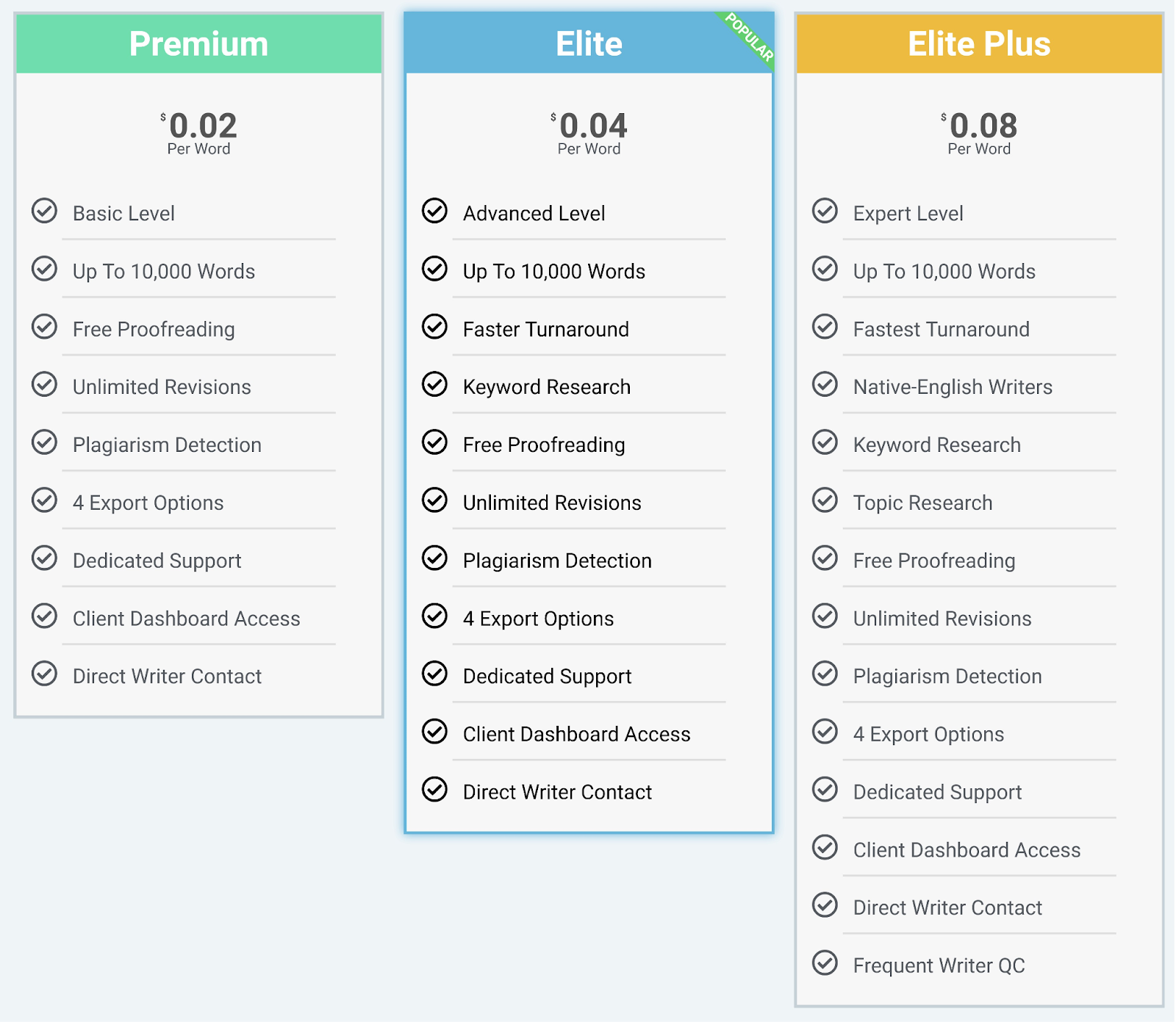
These rates are attractive to businesses looking to keep content marketing costs low.
Unfortunately, rates this low mean writers often have to sacrifice quality for quantity to make a living.
But fast writers keep volume high, which keeps clients happy and orders coming in. This, in turn, keeps writers working.
And that’s how mills keep churning.
Content Mills vs. Content Marketing Agencies
A content mill is all about quantity. Their main focus is pumping out content to fit a topic or keyword.
Companies that use mills grab their audience’s attention by flooding their marketing channels with content.
For example, an IT support company might identify “Dell laptop repairs” as a popular keyword. Ordering and publishing 100 articles based on that phrase gives them a fast boost in search engine visibility.
But it’s short-term thinking. Low rates and tight timescales mean writers’ research is minimal. This results in inaccurate or thin content and eventually loss of organic traffic.
But more on how you can use content mills to your advantage later.
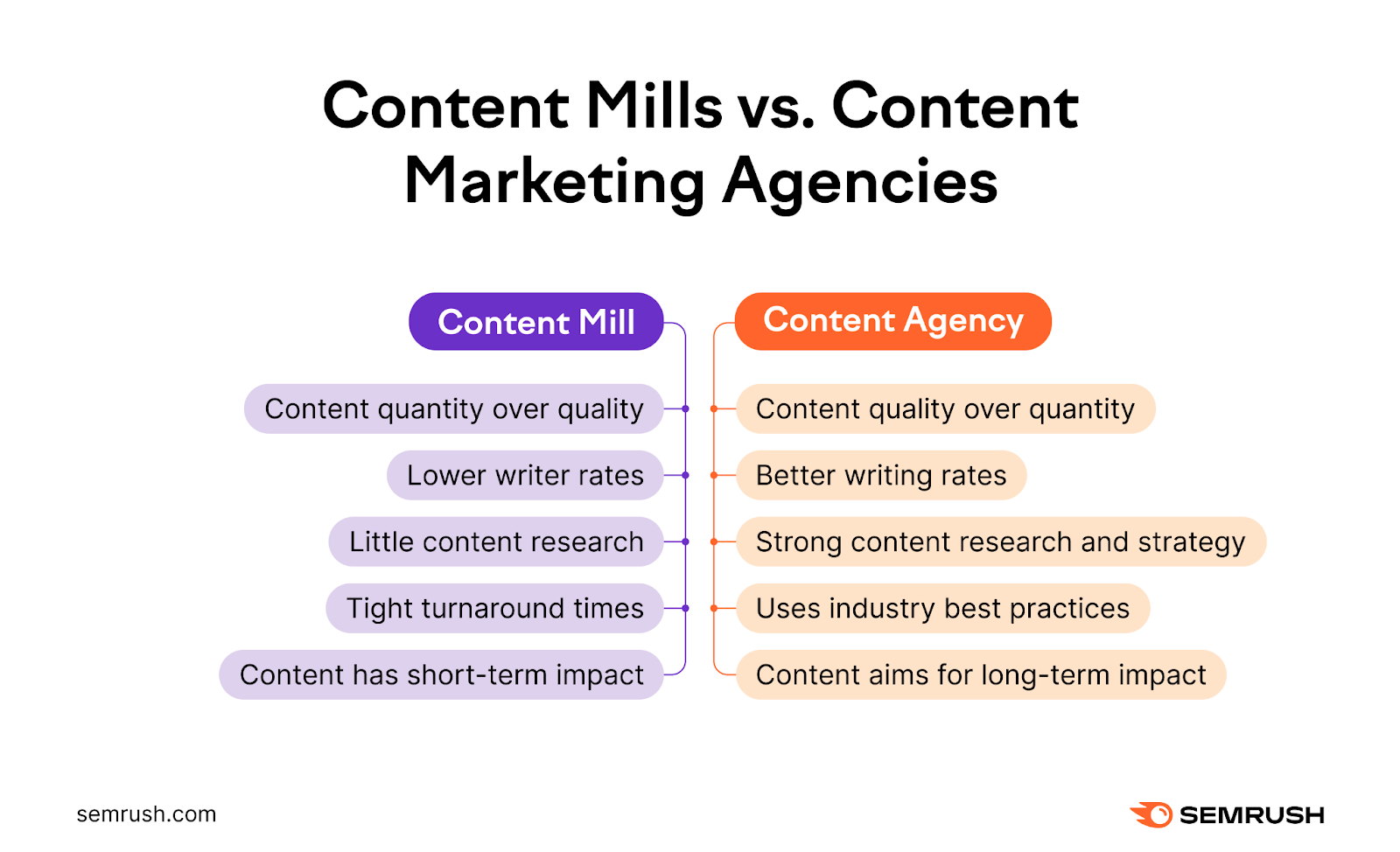
On the other hand, a content marketing agency focuses on quality over quantity. Their strategy and long-term thinking help clients achieve their goals.
Agency teams are made up of experienced writers, editors, marketers, and SEOs who take the time to:
This expertise comes at a cost. Clients might pay hundreds or thousands of dollars per month for agency services.
This means better rates for writers.
The average salary for a marketing agency content writer is $55,000. Most of these writers create a small number of high-quality pieces of content per week.
You’d have to write 200 articles with 1,000 words each to make the same salary at a content mill paying 2 cents per word.
Granted, time served is a big factor. An agency writer likely has a few years of industry writing experience under their belt. Most content mill writers are at the start of their career.
But it gives you an idea how different the salaries and workloads are. And why, for content mills, quantity is everything.
What Does Writing for a Content Mill Look Like?
The process of writing for a content mill differs by company. Typical steps are:
- Complete an online writer application or submit a portfolio
- Take a grammar or English proficiency test
- Submit an audition article or piece of writing based on a prompt
Each content mill has its own standards for grading writers. Getting accepted by one company doesn’t mean you’ll be accepted by all of them.
Once you’re in, you bid on projects that interest you based on topic, word count, and pay rate. If the client accepts your bid, you complete the project and submit it for review.
The client will either request amendments or mark the project complete and payment is released.
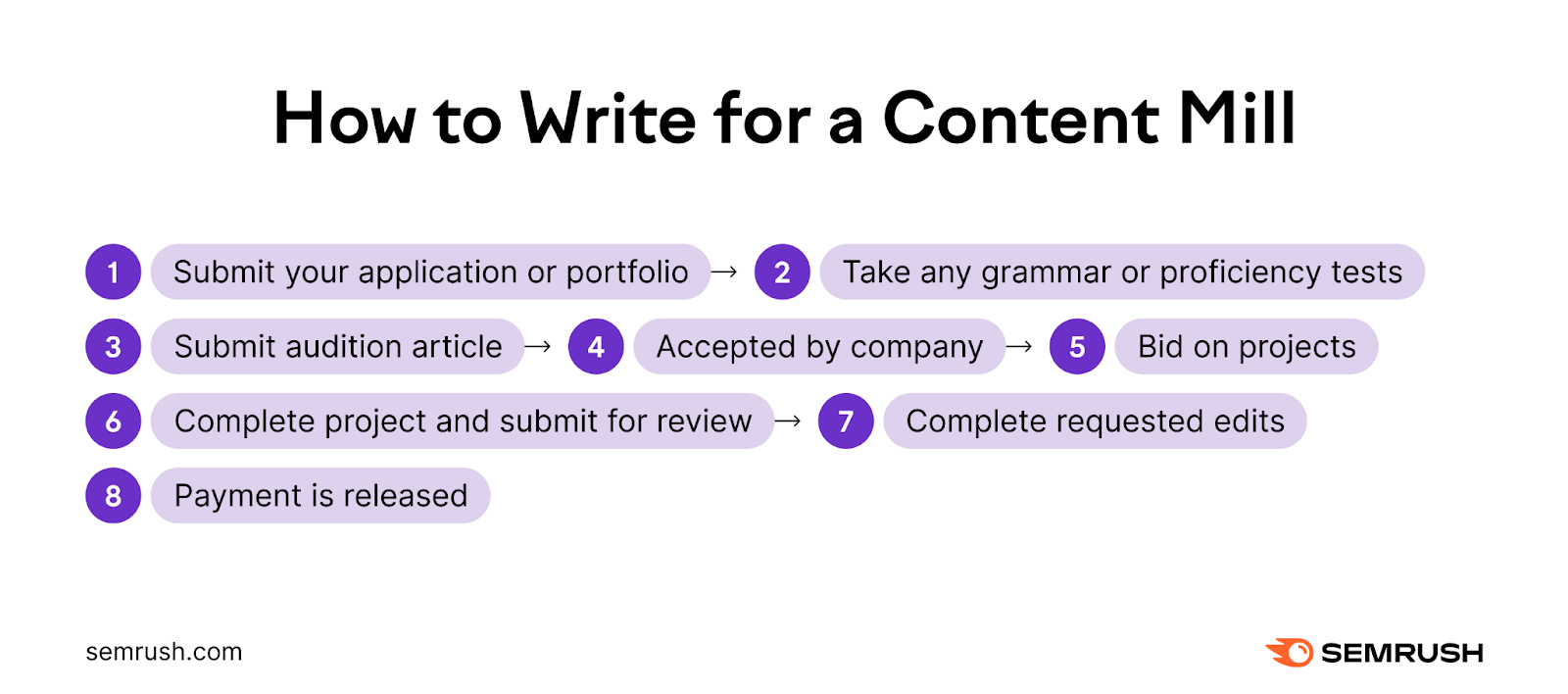
Most content mills don’t pay you automatically. Your payment goes into an intermediary holding account you withdraw money from. In some cases, you need to reach a certain threshold before cashing out (e.g., $10).
Besides getting paid, your biggest goal as a content mill writer is to get as many good reviews as possible.
A higher ranking or rating makes you more appealing to clients. It also opens the door to higher-paying projects.
6 Popular Content Mills
As an example of how each company or platform differs, here are six popular content mills, what they typically pay, and how to get in.
Textbroker

Textbroker is one of the biggest content mills and boasts clients such as eBay and Staples.
Rates range from 1.1 cents to 5.5 cents per word. You can request a payout via PayPal only when your account balance reaches $10.
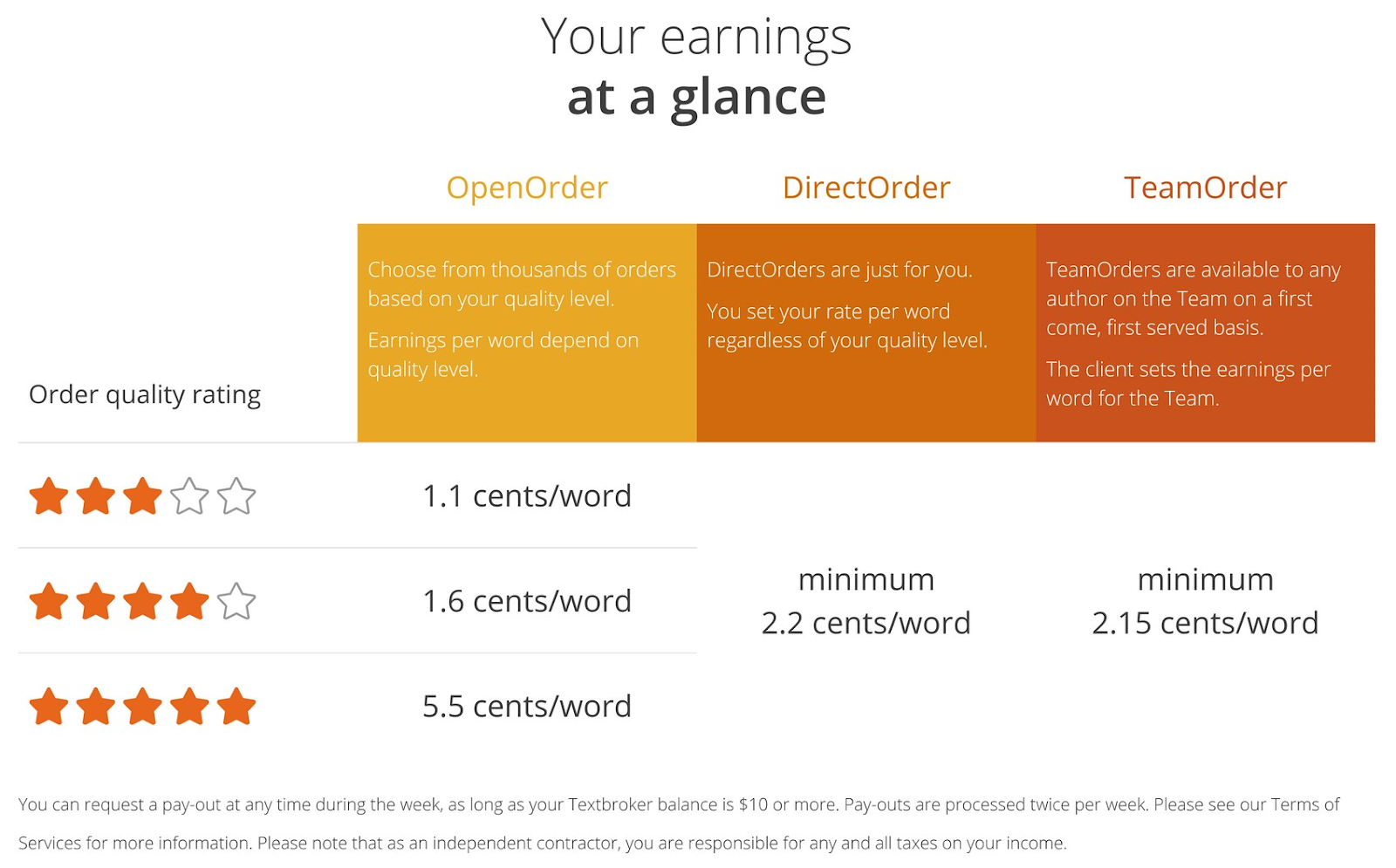
To start with Textbroker, you have to be over 18 years old and a U.S. citizen.
Textbroker asks you to submit a 200-plus word writing sample on a topic of your choice. Editors review the piece and provide a rating from three to five stars. This reflects your content quality and payment rates.
ClearVoice

Unlike other content mills, ClearVoice lets writers pitch directly to clients. They also recommend clients who match your criteria.
However, this service costs a finder’s fee for every successful project, which eats away at your earnings.
To get started with ClearVoice you have to submit a writer’s CV that includes your role and specialties.
You can set a minimum rate for receiving notifications about projects. In theory, this could increase your earning potential, but project fees are often low. To land more gigs, you’ll need to set a competitive rate.
WriterAccess

As with Textbroker, WriterAccess uses a quality-based grading system to set your pay. Rates range from 1.1 to 4 cents per word.
The application process is more thorough. You need to connect your LinkedIn profile and submit a resume, as shown below.

WriterAccess gives you a portfolio to show off your expertise to clients. You can use their AI search to find projects that match your skills.
Landing a job works in two ways:
1. Choose a job from the open gig list
2. Apply to a casting call, where clients choose from a small **** of writers
Contently

Contently positions itself as a content marketing platform as opposed to simply a content mill.
Companies can use Contently for writing, design, photography, and videography. All projects can be managed from a single dashboard.
There’s no job board or bidding here. Writing work is based on the portfolio you create when you join Contently’s network. This showcases your work and expertise to clients. Contently uses it to recommend you for projects that suit your skills.
The downside to this is you can’t proactively search for work. You have to wait for Contently’s team to contact you.
Contently boasts clients such as American Express, Dell, and Marriott. Having such high-caliber clients means rates are more favorable than other content mills.
The platform also has dedicated publications where writers can earn $300-$400 per article.
Verblio

Verblio (formerly known as Blogmutt) is another content mill similar to Textbroker.
To use the platform, you need to be a U.S. citizen with a valid social security number (SSN). You also need to prove your skills by:
- Passing a grammar test
- Completing a plagiarism training module
- Submitting a writing sample for review
Verblio prides themselves on having diverse and interesting clients, including companies in niche industries:
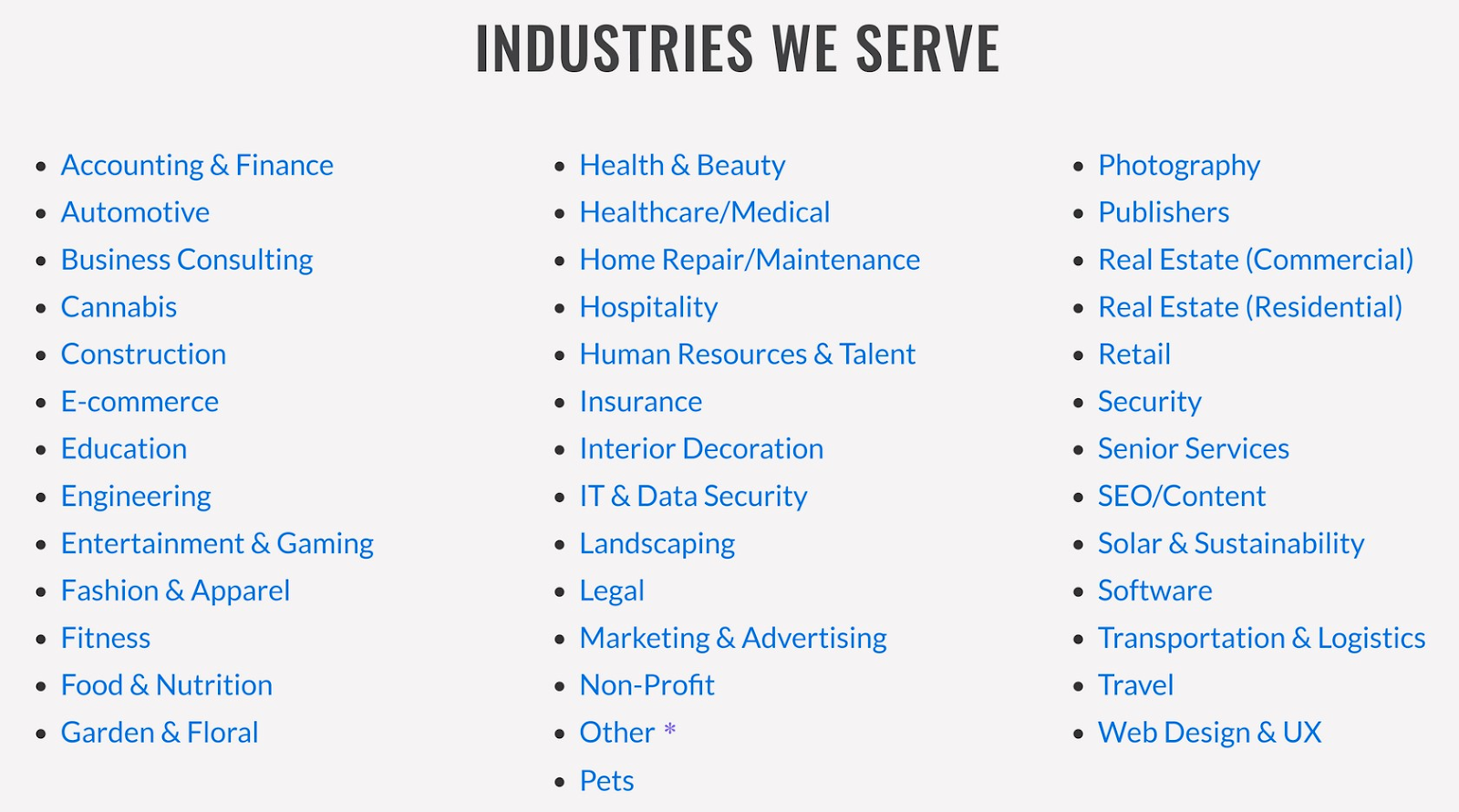
Pay at Verblio starts at $11.50 for a 300-400 word post. This rate increases as your experience and star rating rise.
Constant Content

Constant Content differs from other platforms in this list in that you sell existing content.
Writers produce a piece of content, set a price for it, and upload it for review. If it’s accepted, it goes live on the Constant Content Marketplace for customers to buy.
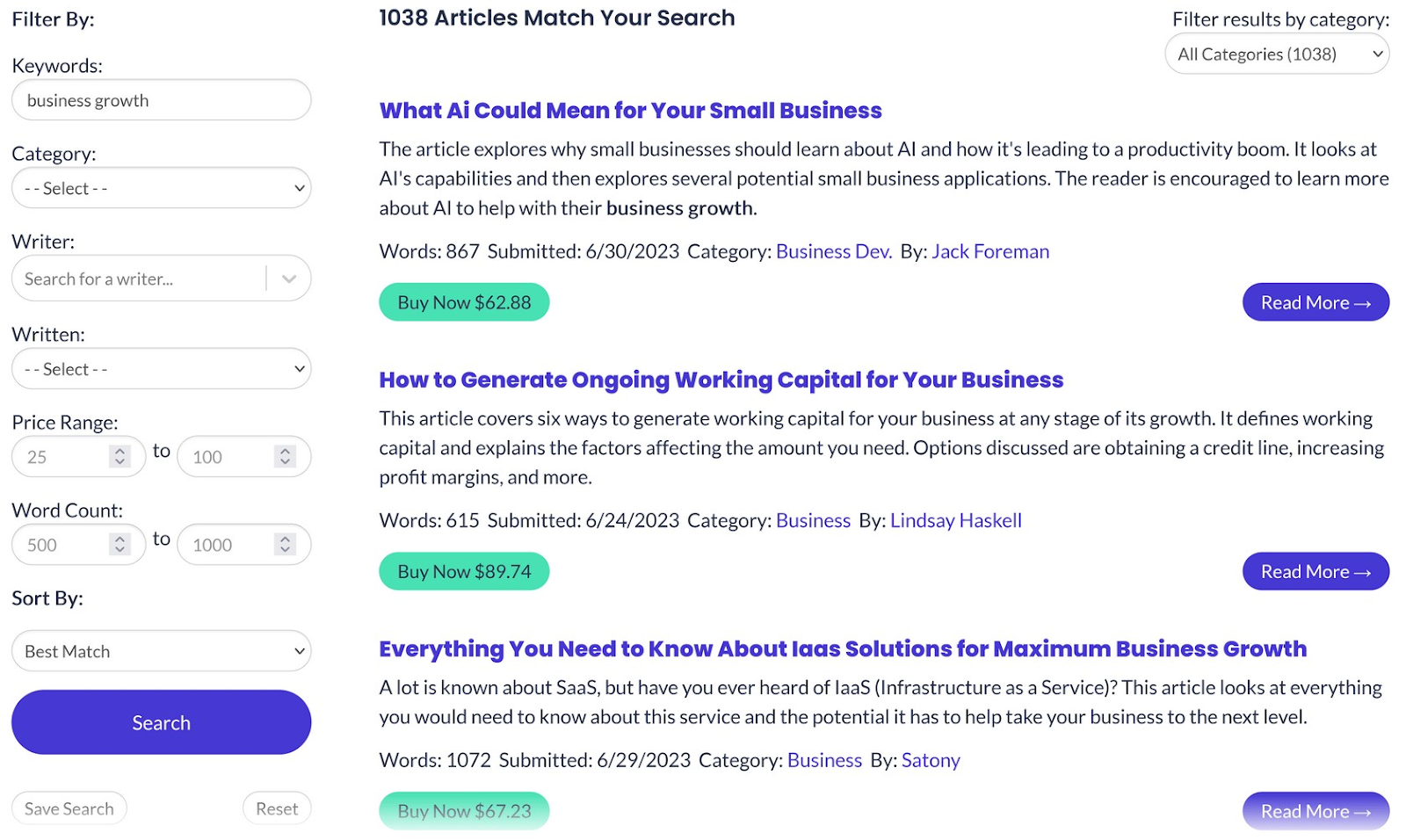
A benefit of this is you can write about whatever you want. The downside is there’s no guarantee your piece will sell.
You’re also competing against hundreds of other writers, so you’ll need to price work competitively.
Constant Content isn’t a great option if you want a steady stream of work. But it can make use of any unpublished articles you have or want to write in your spare time.
Why Content Mills are Problematic
The biggest issue with content mills is the rates.
Pay that doesn’t reflect the work you put into creating content is by far a complaint from freelance writers who have spent any time using mills.
To keep costs low for clients, content mills keep rates low for writers.
Low pay means writers need to work longer, harder, and faster to make a living.
It becomes a process of: write, finish, hand over, repeat. Time for researching and pouring your heart and soul into creating the best possible piece of work often isn’t possible.
Faced with a lot of work and quick turnarounds, you have to cut corners.
On top of this, you typically work to a strict word count (e.g. a 500-word article or 5,000-word ebook). This means you may either have to hold back on value or fluff out pieces with irrelevant filler content to meet targets.
The need to win bids to get paid also creates more competition. This turns job boards into a race to the bottom.
Take this example of a job post on Freelancer.com:

Writing 13,000 words for $90 works out at a little over half a cent per word. Yet the project attracted over 100 bids—many of which were $50.
Compare this to a freelance writing rates study by Peak Freelance, which found the most popular rate for a 1,500-word blog post was $250 to $399.
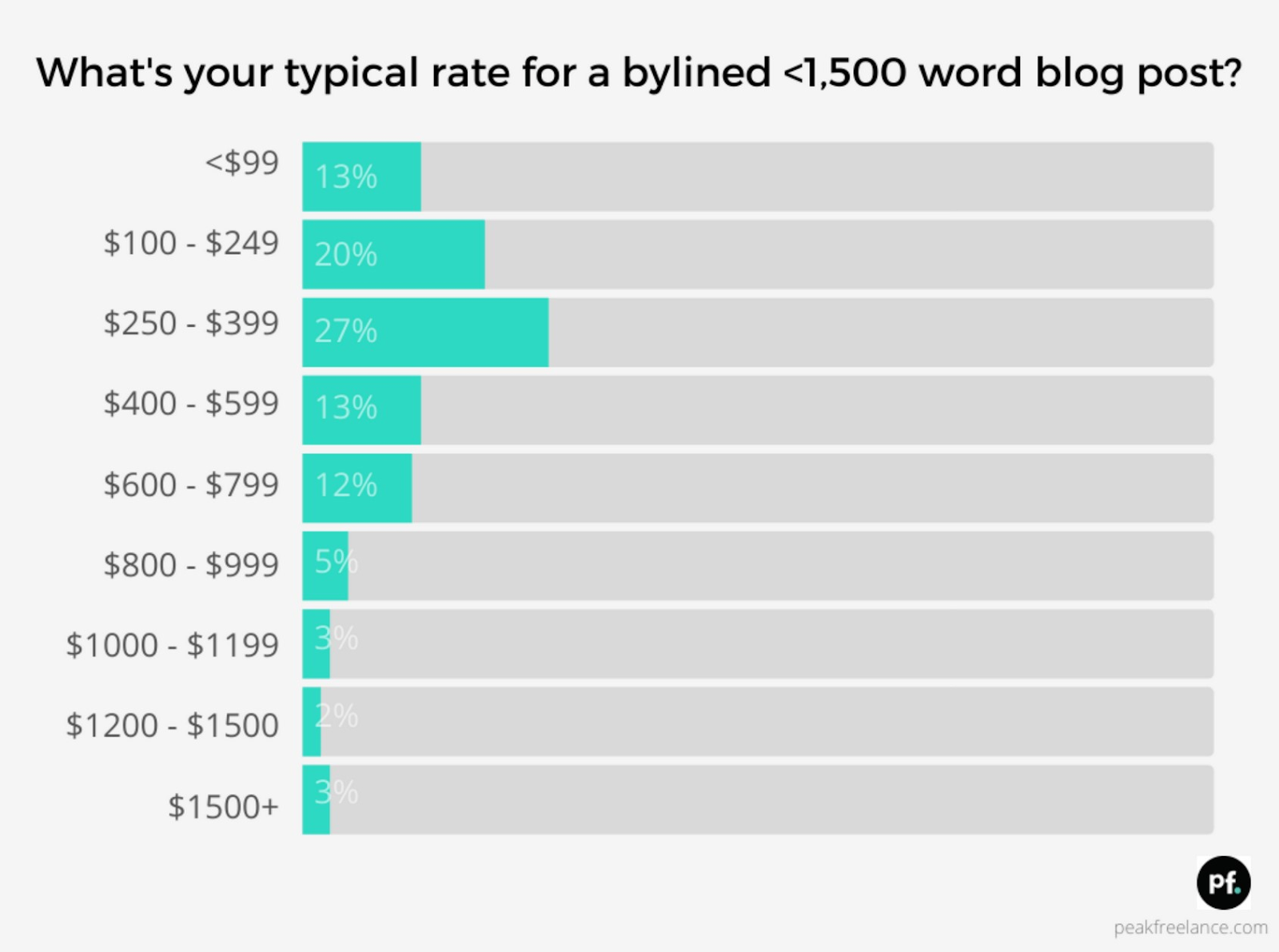
It’s a simple supply and demand problem.
If companies can get work done at bottom-of-the-barrel prices, there’s little incentive to pay more. Especially if their primary concern is quantity, not quality.
In many cases, the low-pay, high-volume model leads to lower standards across the board, including:
- Thin briefs that lack business goals, audience insights, or tone of voice guidelines
- Lack of feedback or editorial process from content mills or clients
- Inability to scale due to competition keeping the price ceiling low
In short, content mills aren’t well suited to writers who want to do work they can be proud of and get paid fairly for.
But if they’re so problematic, why do thousands of writers use them?
Because in the right circumstances, they can work in your favor.
The Case for Content Mills
If you’re a beginner and want to get paid for writing, a content mill can make sense.
You can land your first freelance writing job without experience or a portfolio. Many writers start out working on content mills for this reason.
They can be a good way to develop writing skills and a professional approach around other commitments such as family or a job.
If you sign up for more than one platform, content mills can provide a consistent stream of work across a broad range of topics and clients. You also get paid quickly.
Unfortunately, the low pay factor outweighs these pros. These platforms are only viable short term.
How to Use Your Time in a Content Mill to Grow as a Writer
For long-term career progression, you have to think beyond content mills.
All writers have to start somewhere and mills can be a good place to practice. What you learn churning out content will contribute to your future writing career.
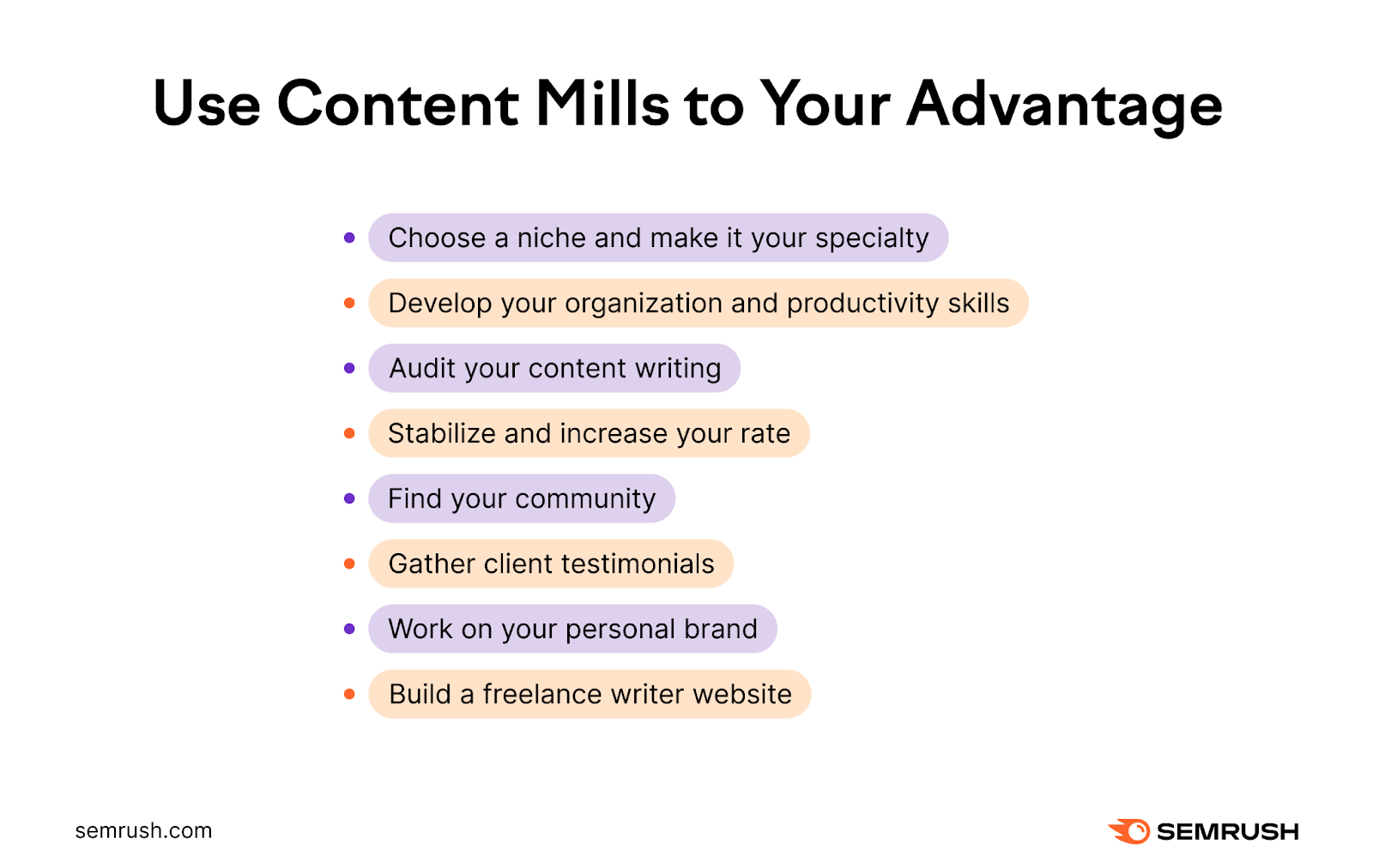
Here’s how to use content mills as a stepping stone to a bright career:
Choose a Niche and Make it Your Specialty
Writing for a content mill opens you up to a wide range of topics. Use this as a way to find a niche that you enjoy writing about and make it your specialty.
Why?
Because a niche will help you become an authority. It helps you move from jack-of-all-trades to a subject expert.
Ultimately, this will lead to you working with better clients for more money.
For example, freelance writer Kat Boogaard grew her business to six figures by establishing herself as an authority in career advice:
I wrote about storage unit insurance. I wrote about healthcare. I wrote about careers. Heck, I even wrote an entire piece about how fish finders work.
As a result, my reputation (not to mention my portfolio) was scattered and unfocused, and I struggled to land the opportunities I really wanted. Career websites just weren’t impressed by my storage unit writing samples.
I knew I needed to narrow things down. After writing a few career profiles for The Everygirl, I realized I loved talking about the world of work—and just like that, my niche was born.
Just to be clear: You can have a specific niche and write about other things. You can also expand your niche to include related topics. Kat Boogaard also writes about productivity, entrepreneurship, and project management.
But having one thing you’re known for will help you stand out from the crowd.
As you take on new projects, ask yourself:
- What topics am I passionate about?
- What expertise do I offer in that industry?
- Is there a demand for it? It’s worth researching how many brands or publications publish content on your topic.
And when you’re ready to dive into a niche, use Semrush’s Topic Research tool to find relevant headlines, questions, and trending topics.
For example, say you want to write exclusively about the pet industry. And you want to write content about food. Enter your topic, select your country, then click “Get content ideas.”
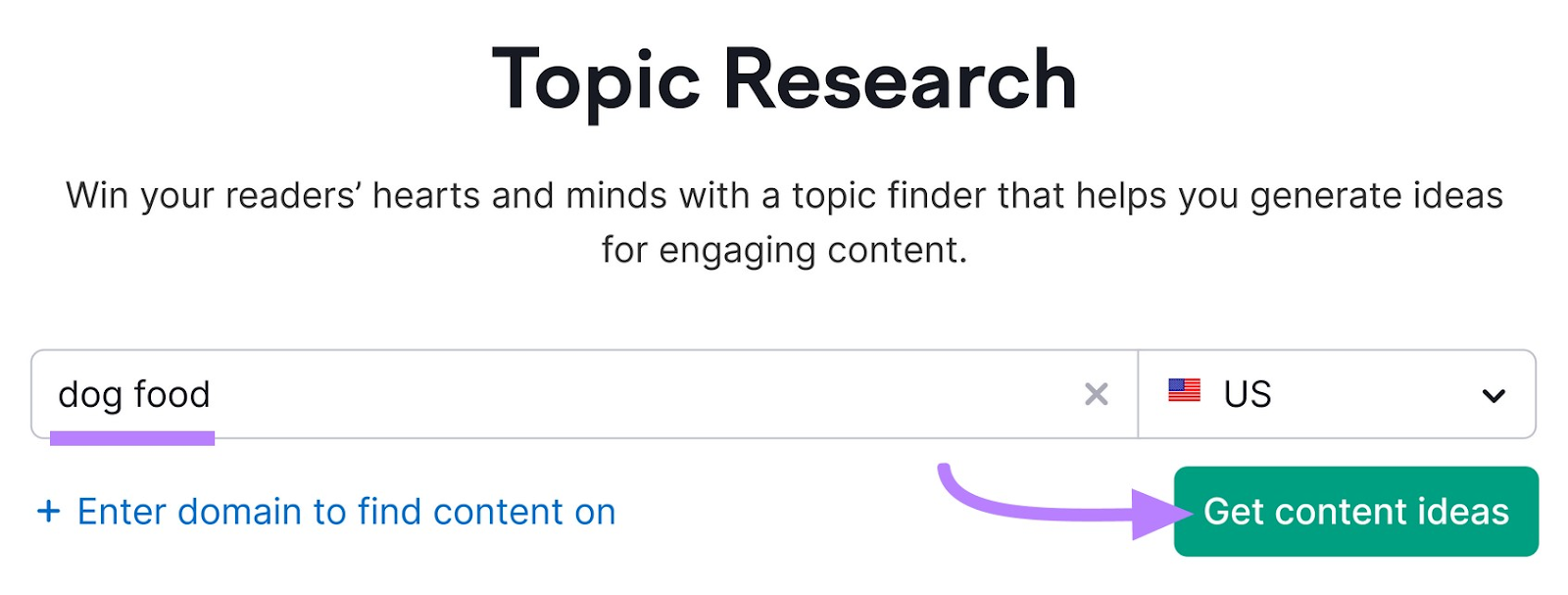
Once the report is ready, click “Show more” on any subtopic card to see headlines, questions, and related searches.
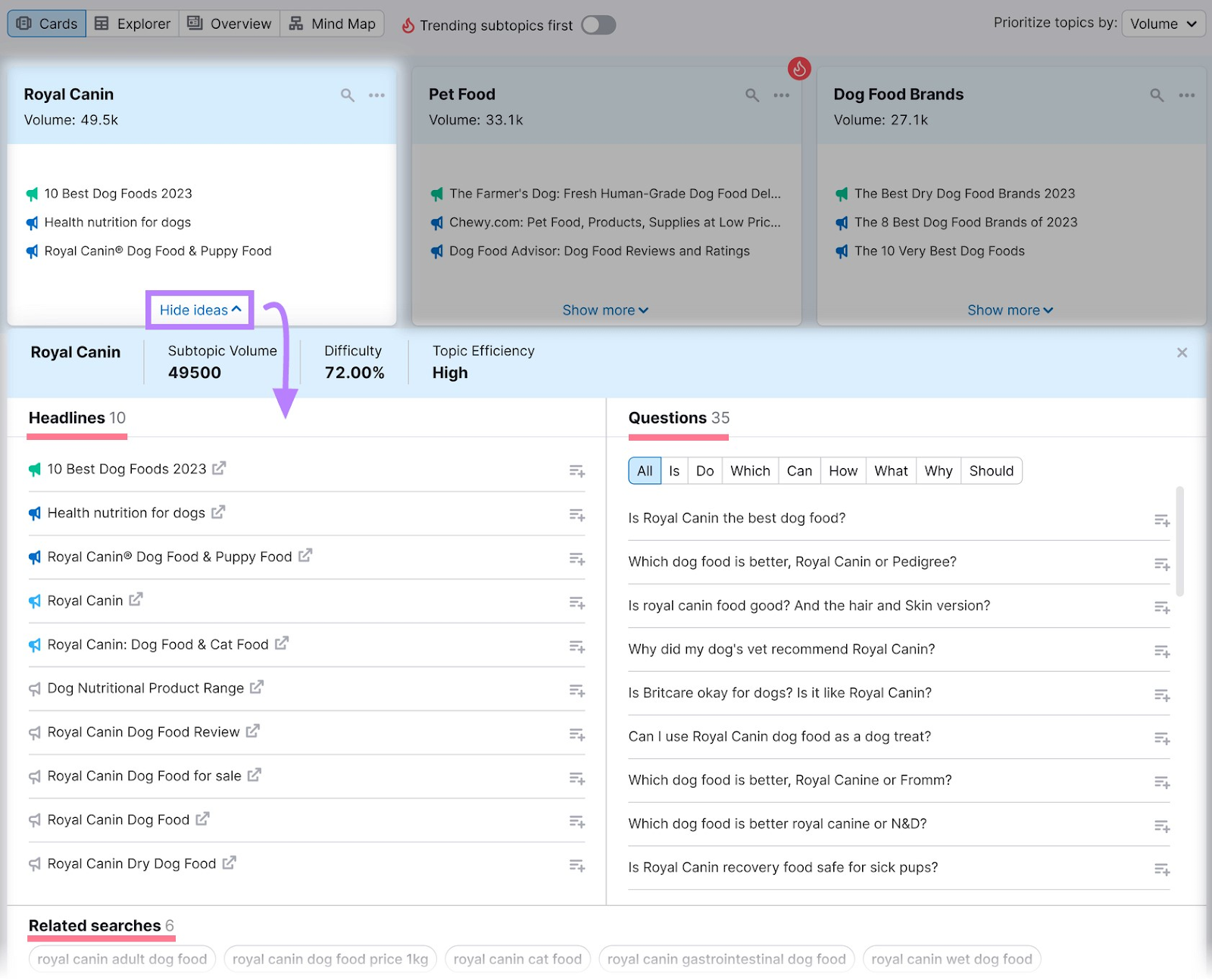
Subtopics marked with a flame icon are trending. Toggle the switch to display “Trending subtopic first.”
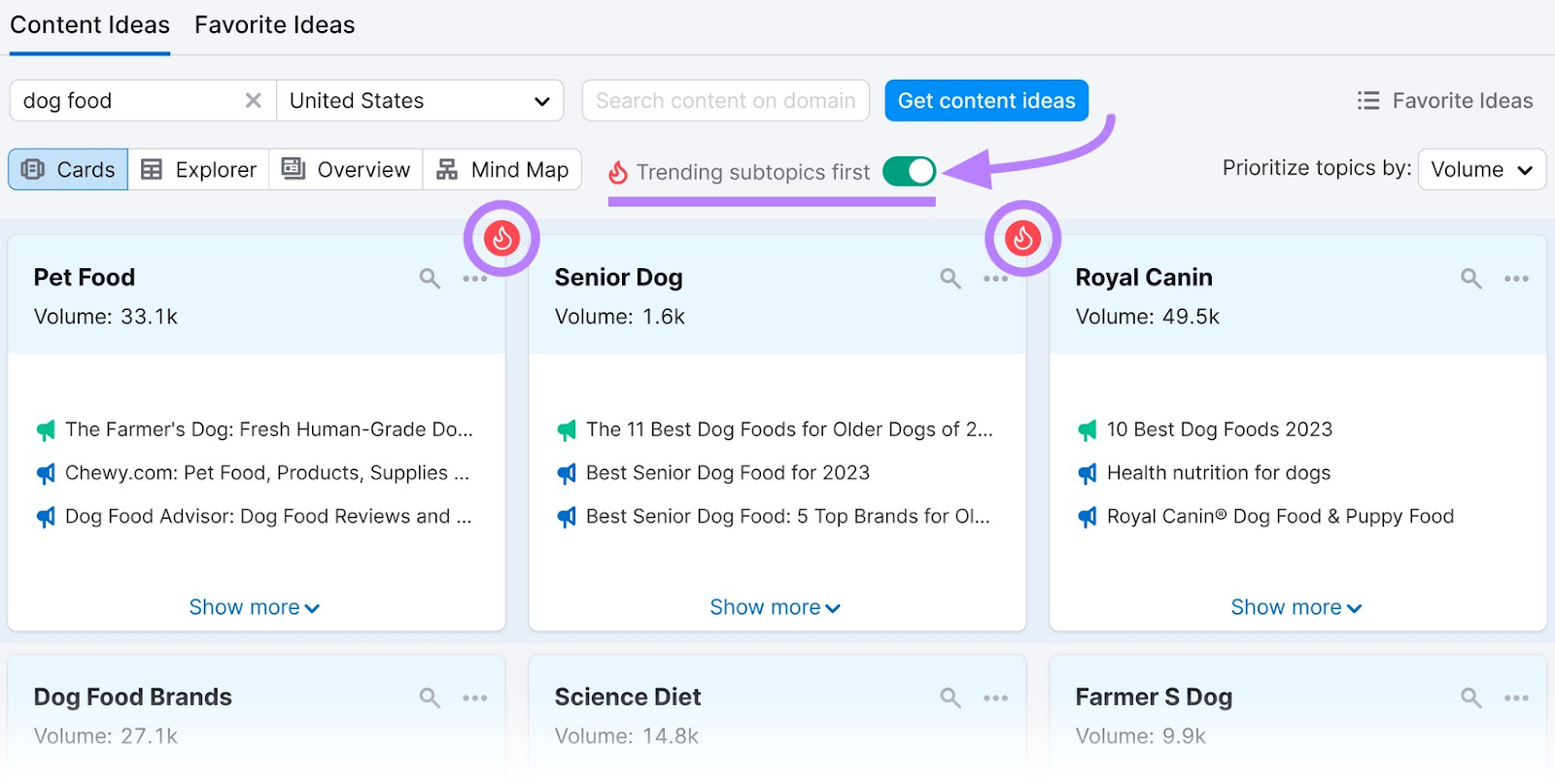
Pro tip: You can also use Semrush’s SEO Content Template and SEO Writing Assistant to create an optimized content piece.
Develop Your Organization and Productivity Skills
Your content mill experience serves as proof you have the self-discipline to meet deadlines. This is important when you work with clients directly.
Use the fast pace and quick turnarounds to get a feel for how and when you work best.
For example, do you focus better in the morning or afternoon? Are you more productive at home or in a cafe?
If you work better at home in the mornings, this can be the time when you do the bulk of your writing. Afternoons can be used for other tasks associated with writing:
- Sending emails
- Pitching clients
- Invoicing clients
- Generating topic ideas
As you establish a routine, experiment with tools to help you cut down work time without impacting quality. Here are a few suggestions:
Turning out great work on time will grow your reputation and keep clients coming back.
Audit Your Content Writing
Gathering feedback is the best way to improve your writing skills.
Unfortunately, this can be hard to come by on content mills. Projects are often signed off immediately or clients request changes with little explanation.
If you can interact directly with a client, ask them what they liked about your content and if there’s anything they’d like to see in future work.
If you don’t have the opportunity for feedback, you can hone your skills by learning from other writers in your niche. Find top industry blogs and publications. Study how they make content engaging and informative:
- How long are the posts?
- How do they structure headlines?
- How do they format posts?
- Do they use examples?
- Do they include images, screenshots, or videos?
- How do they use calls to action (CTAs)?
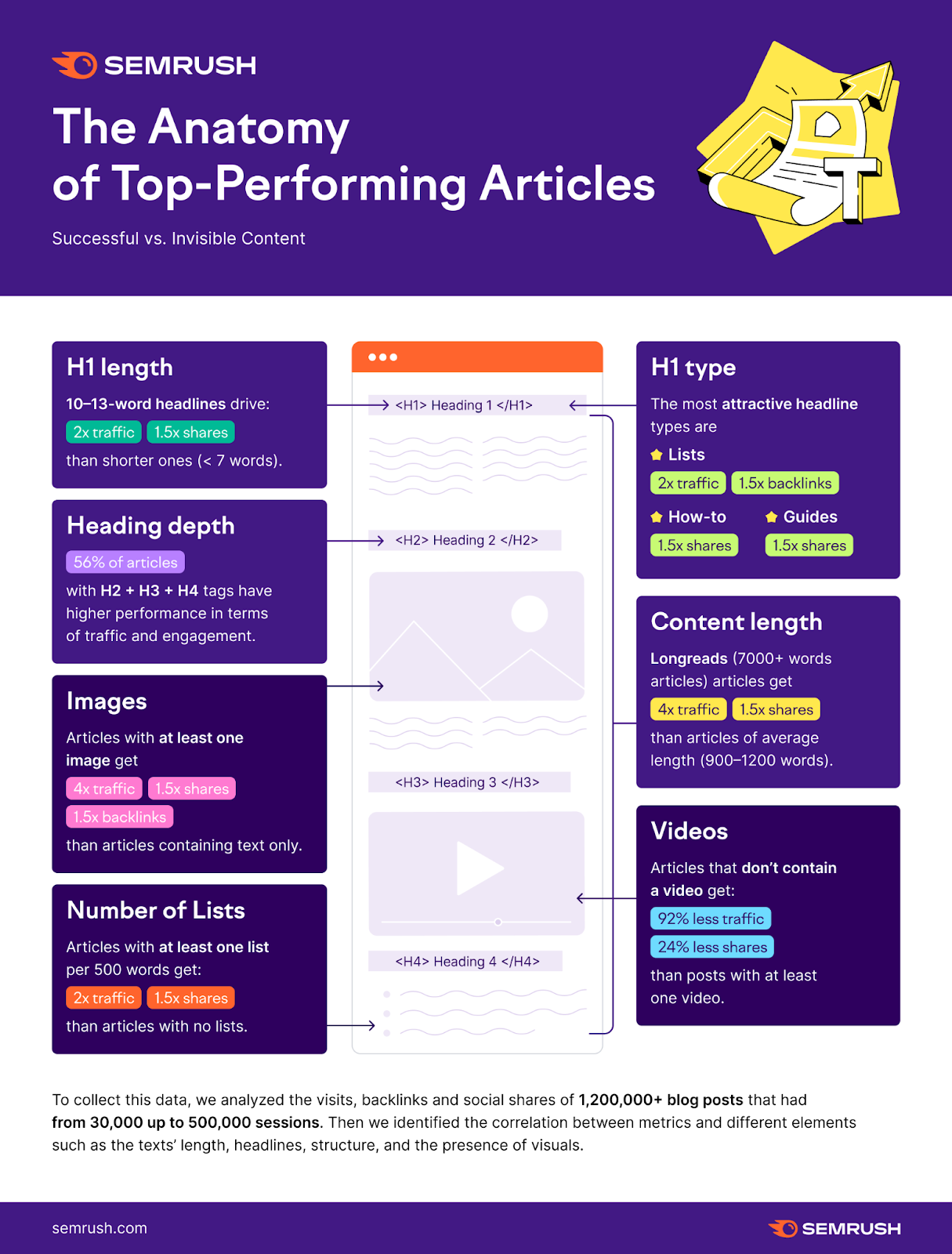
High-paying clients want valuable content that’s delivered in an easily digestible format. By mimicking successful content, you’ll hone your skills and attract clients of your own.
Pro tip: You can level up your writing by learning about SEO, a desired skill by many content creation companies.
Stabilize and Increase Your Rate
You’re not getting paid enough as it is. Dropping your rates to win a project only sets a bar you’ll struggle to raise.
Remember: Clients will expect the same quality of work at the lower rate. And you’ll only cause yourself more stress trying to work faster to maintain an average income.
Know your value and stick to your principles.
Will this mean missing out on work?
Probably.
But there are things you can do to grow as a writer that will be more beneficial in the long run:
- Create writing samples. For example, start blogging on a platform like Medium or Wordpress.com.
- Look for guest blogging opportunities in your niche. These will give you the chance to earn bylines.
- Search job boards. Use Indeed or LinkedIn Jobs to find higher-paying freelance writing gigs.
- Subscribe to industry newsletters and publications. Increase your niche knowledge and truly become an expert.
A freelance community lets you network with fellow writers in a way that isn’t possible in a content mill.
Within the confines of a mill, every writer is a competitor looking out for their own interests. It’s not an environment for collaboration and communication. But these things are critical to growth.
An active community is a place to:
- Ask questions
- Get advice
- Share ideas
- Learn new ways of working
- Find referrals
- Vent on frustrations
- Celebrate your wins
All of which help you transition away from content mills and become a better writer with higher-paying clients.
Here are some communities to check out:
Gather Client Testimonials
In the absence of published work under your own name, testimonials are a great way to convince clients to hire you.
Reviews of your work are social proof. They give prospects confidence you’re the right person for the job.
The more reviews you have, the more it shows potential clients you have a track record of delivering quality work. It makes you a safe bet.
If a client is happy with your work, ask for a review. Help make feedback relevant by offering prompts or reminding them of the project details.
For example, if your exchange is over email, it can be as simple as this:
Thank you, [client name]! I’m glad you’re happy with my work.
Would it be okay for me to use your feedback as a testimonial?
Screenshot your best testimonials. Use them to secure your first clients outside of content mills.
Work on Your Personal Brand
A strong personal brand ensures your target audience knows who you are, what you stand for, and why they should choose you.
Honing your brand while you’re working the content mills will help you stand out from the competition. It will also sow the seeds for being an expert in your niche.
Listing the publications you’ve worked with, it adds weight to your personal brand.
Your portfolio also works to hammer home your area of expertise, focusing specifically on published articles about your chosen niche.
Like in this example of a writer specializing in money-saving tips:

This establishes you as a name people think of when they need a certain type of content.
Use your content mill profiles to clarify your niche and the value you bring. Showcase work that’s relevant to your ideal clients.
Expand this to social media:
- Post about topics related to your niche
- Follow and interact with people in your industry
- Use industry hashtags to amplify posts and find conversations to join
The more people who are aware of your specialty, the easier it is to become a go-to source.
The result?
More leads, referrals, and an easier transition from content mills to clients of your own.
Build a Freelance Writer Website
A website isn’t something you need when working for content mills, but it’s essential to have when you leave them behind.
You can use a website to:
- House your portfolio
- Showcase your niche expertise
- Grow your personal brand
- Create and share content
Start building a website alongside your content mill work. This way, when you’re ready to make the leap, you have somewhere to send prospective clients.
A website doesn’t need to be expensive or elaborate. It should include your services, a personal profile, testimonials, and a contact form.
You can build a simple personal website using a customizable template on a web builder platform such as WordPress.com, Wix, or Squarespace. All offer low-cost personal plans and include a domain name and hosting.
Tip: You can also build your LinkedIn profile to do all the above as well. For free.
Advance Beyond Content Mills
There’s no getting away from the negatives of content mills. But if you’re completely new to freelance writing they can be a positive learning experience.
Think about what you want your writing career to look like. If you decide to give content mills a go, use your time there to develop and grow as a writer.
If you’re ready to get out of the content mills and break into content writing, level up your skills with these 14 writing tips or see how Semrush’s SEO Writing Assistant can help you write better content.
Source link : Semrush.com



